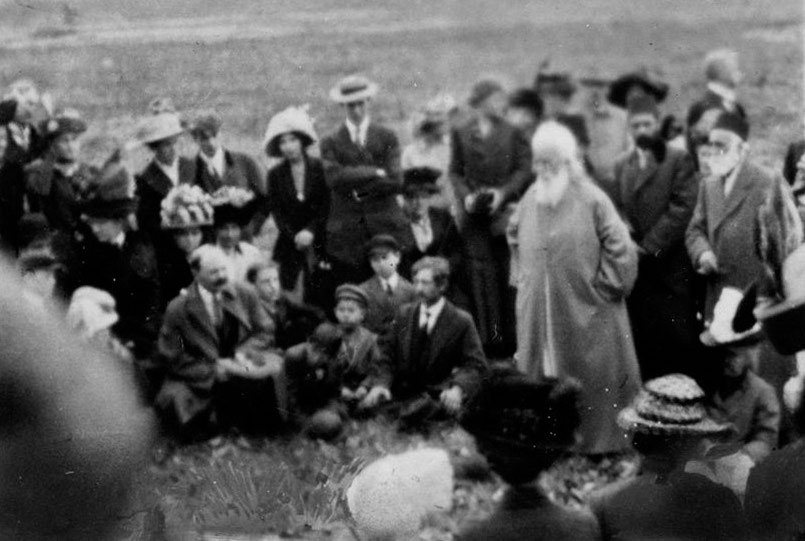
This introduction to the institution of the Mashriqu’l-Adhkár includes the basic texts describing this unique institution, and an introduction to the eight continental Houses of Worship, including when available some information around their dedication, since I personally assisted at four of those events and have visited all but one. These are at Wilmette, Illinois, USA (1953); Kampala, Uganda, 1961; Sydney, Australia, 1961; Langenhain, near Frankfurt, Germany, 1964; Panama City, Panama, 1972; Apia, Samoa, 1984; New Delhi, India, 1986; and Santiago, Chile, 2016. Since then, the Bahá'ís have started to build national and local Houses of Worship in Cambodia, Colombia, Kenya, Vanuatu, Congo DR, Papua New Guinea and India.
O people of the world! Build ye houses of worship throughout the lands in the name of Him Who is the Lord of all religions. Make them as perfect as is possible in the world of being, and adorn them with that which befitteth them, not with images and effigies. Then, with radiance and joy, celebrate therein the praise of your Lord, the Most Compassionate. Verily, by His remembrance the eye is cheered and the heart is filled with light. (Bahá’u’lláh, Kitáb-i-Aqdas – The Most Holy Book, §31)
Blessed is he who, at the hour of dawn, centring his thoughts on God, occupied with His remembrance, and supplicating His forgiveness, directeth his steps to the Mashriqu’l-Adhkár and, entering therein, seateth himself in silence to listen to the verses of God, the Sovereign, the Mighty, the All-Praised. Say: The Mashriqu’l-Adhkár is each and every building which hath been erected in cities and villages for the celebration of My praise. (Bahá’u’lláh, Kitáb-i-Aqdas – The Most Holy Book, §115)
Teach your children the verses revealed from the heaven of majesty and power, so that, in most melodious tones, they may recite the Tablets of the All-Merciful in the alcoves within the Mashriqu’l-Adhkárs. ...recite the verses of God in such wise as to captivate the hearts of those yet wrapped in slumber. (Bahá’u’lláh, Kitáb-i-Aqdas – The Most Holy Book, §150)
It befitteth the friends to hold a gathering, a meeting, where they shall glorify God and fix their hearts upon Him, and read and recite the Holy Writings of the Blessed Beauty…. these are none other than the Mashriqu’l-Adhkárs, the Dawning-Points of God’s Remembrance, which must, at the direction of the Most Exalted Pen, be established in every hamlet and city.... (‘Abdu’l-Bahá, Selections from the Writings of ‘Abdu’l-Bahá, §55)
Thou hast asked about places of worship and the underlying reason therefor. The wisdom in raising up such buildings is that at a given hour, the people should know it is time to meet, and all should gather together, and, harmoniously attuned one to another, engage in prayer; with the result that out of this coming together, unity and affection shall grow and flourish in the human heart. (‘Abdu’l-Bahá, Selections from the Writings of ‘Abdu’l-Bahá, §58)
Although to outward seeming the Mashriqu’l-Adhkár is a material structure, yet it hath a spiritual effect. It forgeth bonds of unity from heart to heart; it is a collective centre for men’s souls…. The edifice of the House of Worship hath a powerful influence on every phase of life. (‘Abdu’l-Bahá, Selections from the Writings of ‘Abdu’l-Bahá, §60)
The Mashriqu’l-Adhkár is one of the most vital institutions in the world, and it hath many subsidiary branches. Although it is a House of Worship, it is also connected with a hospital, a drug dispensary, a traveller’s hospice, a school for orphans, and a university for advanced studies. Every Mashriqu’l-Adhkár is connected with these five things…. this ‘Dawning-Point of the Remembrance of God.’ (‘Abdu’l-Bahá, Selections from the Writings of ‘Abdu’l-Bahá, §64)
It should be borne in mind that the central Edifice of the Mashriqu’l-Adhkár, round which in the fulness of time shall cluster such institutions of social service as shall afford relief to the suffering, sustenance to the poor, shelter to the wayfarer, solace to the bereaved, and education to the ignorant, should be regarded apart from these Dependencies, as a House solely designed and entirely dedicated to the worship of God.…
But however inspiring the conception of Bahá’í worship, as witnessed in the central Edifice of this exalted Temple, it cannot be regarded as the sole, nor even the essential, factor in the part which the Mashriqu’l-Adhkár, as designed by Bahá’u’lláh, is destined to play in the organic life of the Bahá’í community.
[including]...the social, humanitarian, educational and scientific pursuits centering around the Dependencies of the Mashriqu’l-Adhkár.
Nothing short of direct and constant interaction between the spiritual forces emanating from this House of Worship centering in the heart of the Mashriqu’l-Adhkár, and the energies consciously displayed by those who administer its affairs in their service to humanity can possibly provide the necessary agency capable of removing the ills that have so long and so grievously afflicted humanity.
...of all the institutions that stand associated with His Holy Name, surely none save the institution of the Mashriqu’l-Adhkár can most adequately provide the essentials of Bahá’í worship and service, both so vital to the regeneration of the world. ...the unique position of the Mashriqu’l-Adhkár as one of the outstanding institutions conceived by Bahá’u’lláh. (Shoghi Effendi, Bahá’í Administration: Selected Messages 1922-1932, letter dated 25 October 1929, pp. 184-186) [Institution §38]
Blessed is the spot, and the house,
and the place, and the city,
and the heart, and the mountain,
and the refuge, and the cave,
and the valley, and the land,
and the sea, and the island,
and the meadow where mention of God hath been made,
and His praise glorified.
Bahá’u’lláh
Pictures of the eight Continental Houses of Worship and their dedication ceremonies 1953-2016
The Continental Bahá'í House of Worship for North America is in Wilmette, Illinois, a suburb of Chicago, on the shore of Lake Michigan.
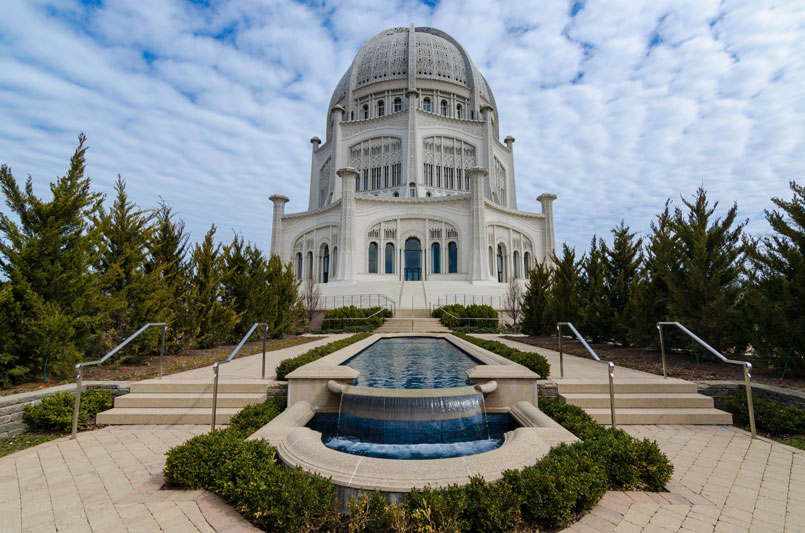
The Bahá'í Faith was introduced to the United States at the Parliament of the World’s Religions meeting in Chicago in 1893. By 1900, there were nearly 1,000 Bahá’ís living in the U.S. and Canada. Plans to construct a Bahá’í temple in the Chicago area emerged in 1903, but it would be another 50 years before the temple was finished.
Two lots were purchased along Lake Michigan in 1907, in what was then Grosse Pointe (now Wilmette). Raising funds for the temple’s construction proved difficult, as it was financed by individual contributions from Bahá’ís around the world. Two World Wars and the Great Depression slowed things down.
Revised fromhttp://www.architecture.org/learn/resources/buildings-of-chicago/building/bahai-house-of-worship/
'Abdu'l-Baha dedicated the site of the House of Worship during His visit to America in 1912. A tent had been erected on the property, and He first gave a talk.
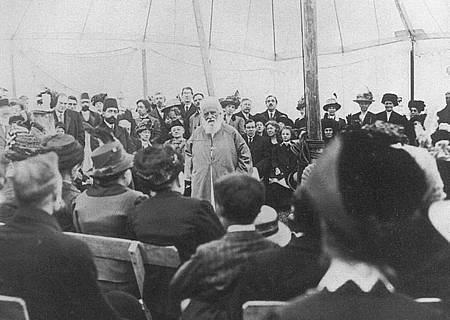
After the talk ‘Abdu’l-Bahá, followed by His audience, left the tent and requested that Nettie Tobin’s stone (a simple stone that had been brought earlier by this poor old lady as her offering) be brought to Him. The stone had been lying several feet northwest of the tent and had probably been pointed out to Him by Corinne True earlier. He walked back and forth on the property and, after asking where the center of the land would be, turned to someone who showed Him the approximate point.
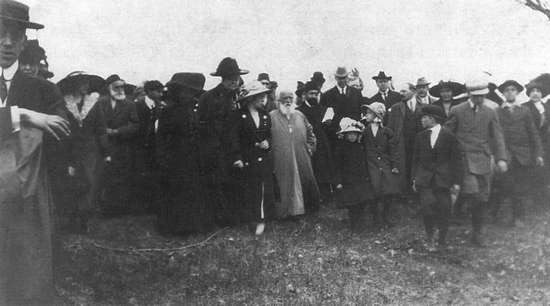
As the stone was being carried to where ‘Abdu’l-Bahá stood, Irene Holmes of New York stepped forward and handed Him a leather case. Inside was a golden trowel she had hoped would be used for laying a cornerstone within the foundation of the building. ‘Abdu’l-Bahá tried to use the trowel to dig a resting place for the dedication stone, but it was too dull to cut through the spring grass. He placed the trowel in its case and asked for more practical tools. When it was discovered that plans had not been made to have such tools available, one of the young men ran to a nearby house to borrow an ax. “Like an athlete”, ‘Abdu’l-Bahá took it and “swung it high in the air.” “After several blows,” wrote Louise Waite, He “cut through the resisting turf and reached the earth below.”

The scene inspired the Bahá’ís to sing-first the “Benediction” and then “Tell the Wondrous Story,” both written by Mrs. Waite. In the meantime another young man, Herbert Anderson of Chicago, had run west on Linden Avenue in search of a shovel. He found a work crew on the Northwestern Elevated tracks about four blocks south of Linden Avenue, near Isabella Street, and convinced them to loan him one of their shovels, which he whisked back to the ceremony. As the shovel was handed to ‘Abdu’l-Bahá, Corinne True reportedly stepped forward and encouraged Him to let a woman participate in the ceremony. Turning to Lua Getsinger, He bade her to come forward despite her resistance. It was not until He called her a second time that she responded, grasped the shovel, and turned the first earth. Following her was Corinne True, after which, one by one, individuals of many races and nationalities-Persian, Syrian, Egyptian, Indian, North American Indian, Japanese, South African, English, French, German, Dutch, Norwegian, Swedish, Danish, Jewish-were called forward to participate in the digging.
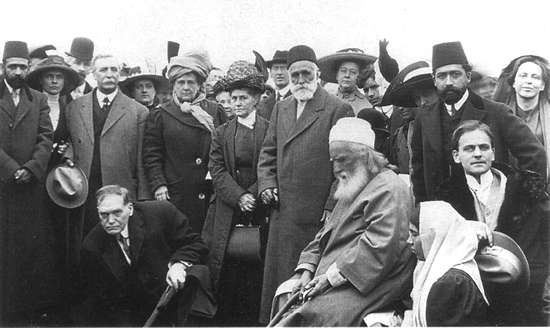
Now that a rather large hole had been dug, ‘Abdu’l-Bahá reached down and scooped up handfuls of dirt, which He shared with several individuals.
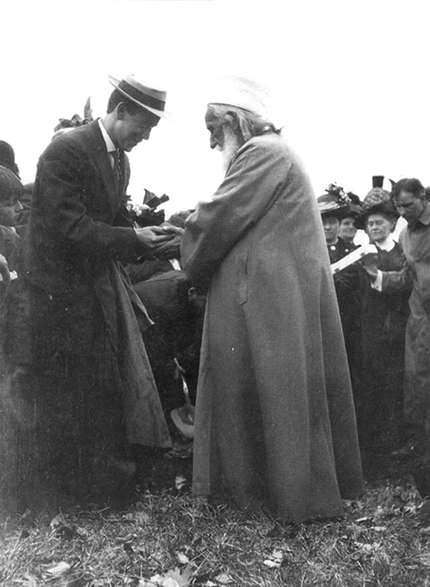
Then He “consigned the stone to its excavation, on behalf of all the people of the world.” After retrieving the golden trowel, He pushed the earth back around the stone and declared: “The Temple is already built.”
Construction began in 1920. The building’s architect, Louis Bourgeois, was a French Canadian who joined the Bahá’í Faith more than a decade before working on the temple. He began his work on the structure in 1920 and moved his studio to a building across the street from the site, to be closer to his project. Bourgeois felt the design of the temple needed to reflect the Bahá’í belief of oneness for humanity, as well as the unity of all religions. In describing his design, he said, “There are combinations of mathematical lines, symbolizing those of the universe, and in their intricate merging of circle into circle, and circle within circle, we visualize the merging of all religions into one.”
The building combines neoclassical symmetry, Gothic ribbing, a Renaissance dome, a Romanesque clerestory and Islamic arabesque tracery with the suggestion of minarets. The carvings on the nine exterior pillars reference various world religions with symbols like the Star of David, crucifixes and the Islamic star and crescent. The gardens contain both rectangular approaches and circular gardens, reflecting Eastern and Western influences.
Selecting a material to realize Bourgeois’ elaborate designs proved difficult. Limestone, granite, terra cotta and aluminum were all considered before concrete was selected. One critic strongly disapproved, calling it “the most repellant object imaginable” since it lacked beauty of the surface and weathered poorly. But John Earley, a fifth generation stone carver who came from a family of ecclesiastical artists, made the concrete beautiful. Inspired by Italian pebble mosaics, Earley developed a method of exposing the larger pebbles in the aggregate of the concrete mixture. This gave the concrete a warmer appearance. On the Bahá’í Temple he used two types of quartz to give the exterior an almost luminescent quality. The result inside and out is stunning, resulting in the structure sometimes being referred to as the “Temple of Light and Unity.” Neither Bourgeois nor Earley saw the completed temple. The formal dedication for the superstructure took place in 1953.
Source:http://www.architecture.org/learn/resources/buildings-of-chicago/building/bahai-house-of-worship/
The Wilmette House of Worship was dedicated by Ruhiyyih Khanum, the wife of the Guardian of the Bahá'í Faith, on 2 May 1953. The ceremony included a viewing of the portraits of The Bab and Bahá'u'lláh which normally can only be seen during pilgrimage to the Bahá'í World Centre in Haifa, Israel.
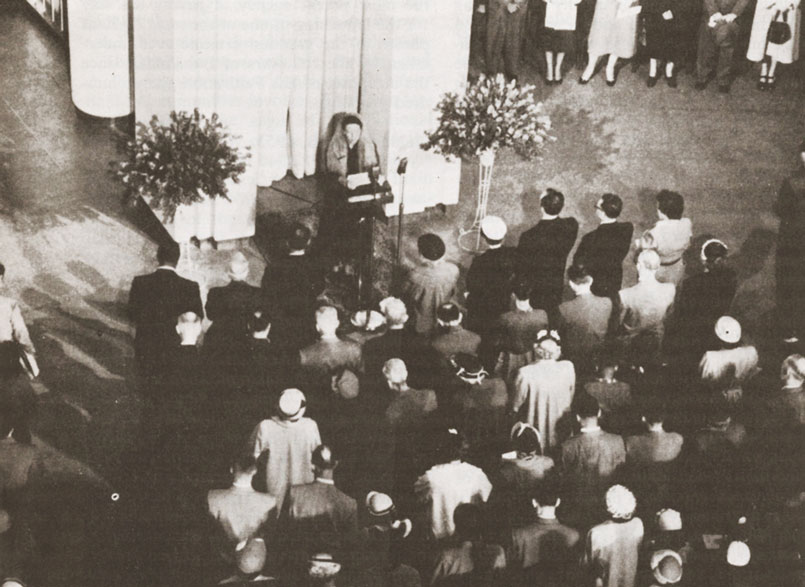
Ruhiyyih Khanum presenting the Guardian’s Message of Dedication of the Baha’i House of Worship, Wilmette, Illinois, 2 May 1953
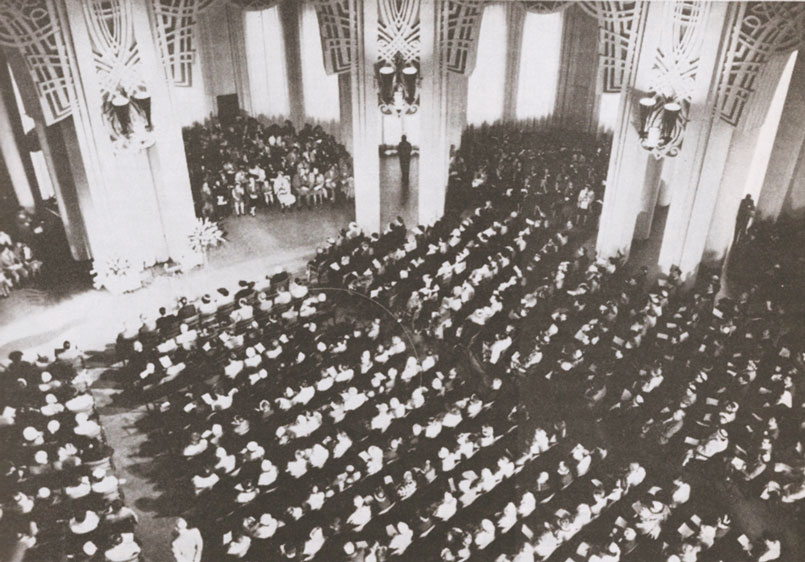
Dedication of the Temple 1953
An All-America Intercontinental Teaching Conference was held at the Masonic Hall in Chicago on 3-6 May 1953 immediately after the dedication. It marked the launching of the Ten Year Spiritual Crusade planned by the Guardian of the Bahá'í Faith to open to the Faith all the remaining countries and territories on the planet that had been mentioned by 'Abdu'l-Bahá in His Tablets of the Divine Plan. I remember sitting in the front row at the session when Ruhiyyih Khanum at the podium on the stage in front of me raised the call of the Guardian for Bahá'ís to arise to pioneer for the Faith to one of these places, many that people had never heard of, and become "Knights of Bahá'u'lláh". Many people I knew went up on that stage. I was only 10, but from that day forward, my goal in life was some day to become a pioneer and help the Bahá'ís in some far off land. It took 21 years before that dream was finally realized when I moved to New Caledonia.
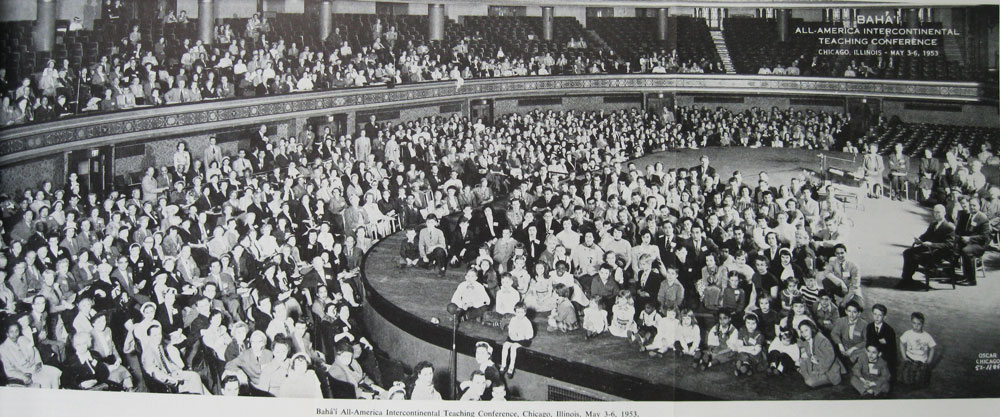
Group photograph at the All-America Intercontinental Teaching Conference
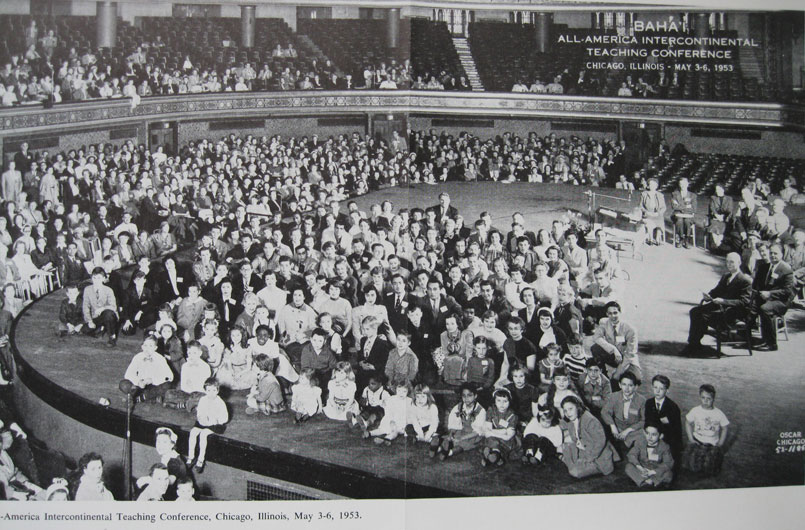
The Hands of the Cause on the right and children on the stage in the centre.
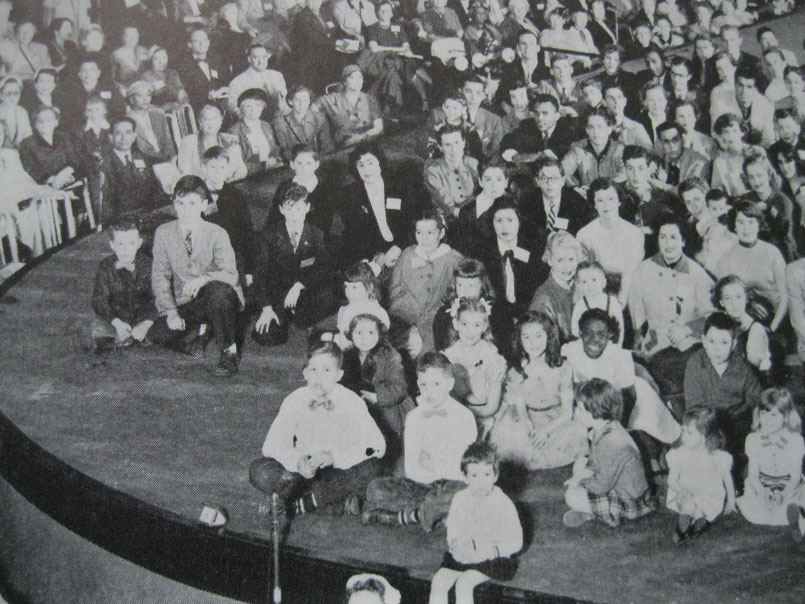
Arthur and Keith Dahl at the conference (to the far left of the group of children, second row)
All temples share certain design features, including domes and gardens. Each temple is nine-sided because Bahá’ís consider the number nine — the highest single number — a symbol of oneness, comprehensiveness and unity. In Wilmette, the temple includes nine entrances and nine verses above the doors and the alcoves. Of all the temples, the Wilmette house of worship is the oldest. It has been named a National Historic Landmark, one of the Seven Wonders of Illinois and is visited by 250,000 people a year. Aside from being called the “Temple of Light and Unity,” the 1100-seat Wilmette building is known as the “Mother Temple of the West” by Bahá’ís around the world. Today, it remains the only Bahá’í temple in the U.S.
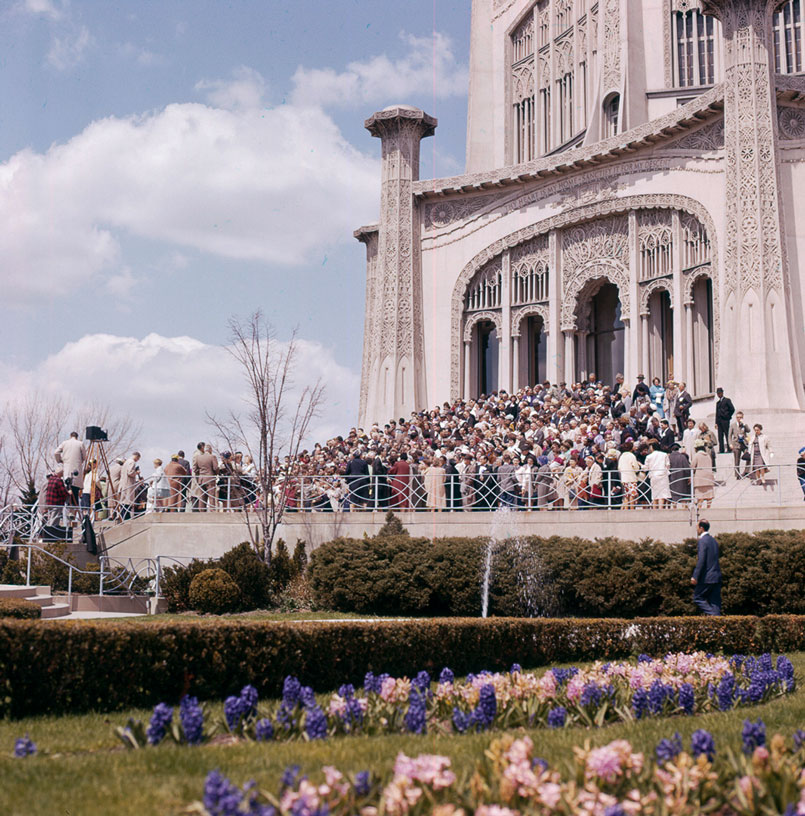
National Bahá'í Convention on the steps in 1961
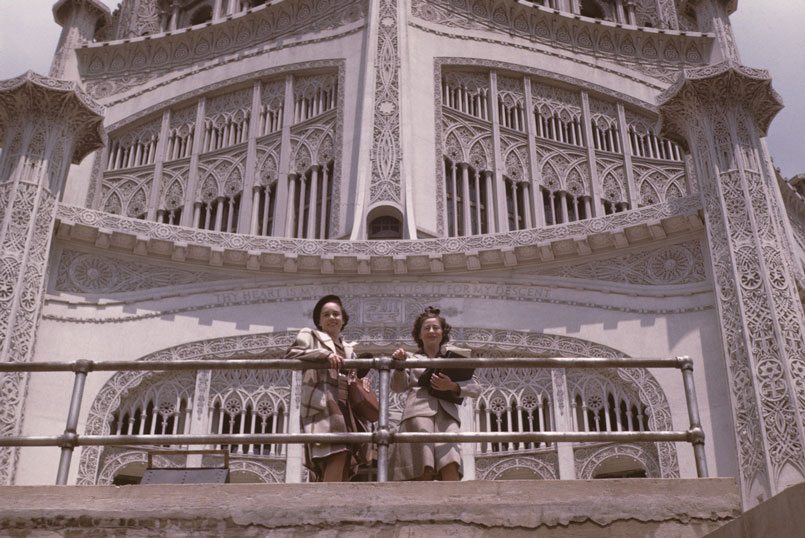
Our friend Nancy Phillips and my mother Joyce Dahl 1944
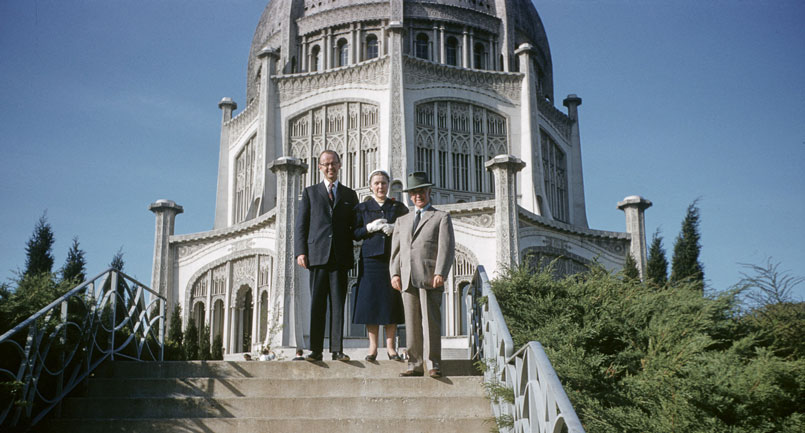
My father Arthur L. Dahl Jr. with the Bishops 1945
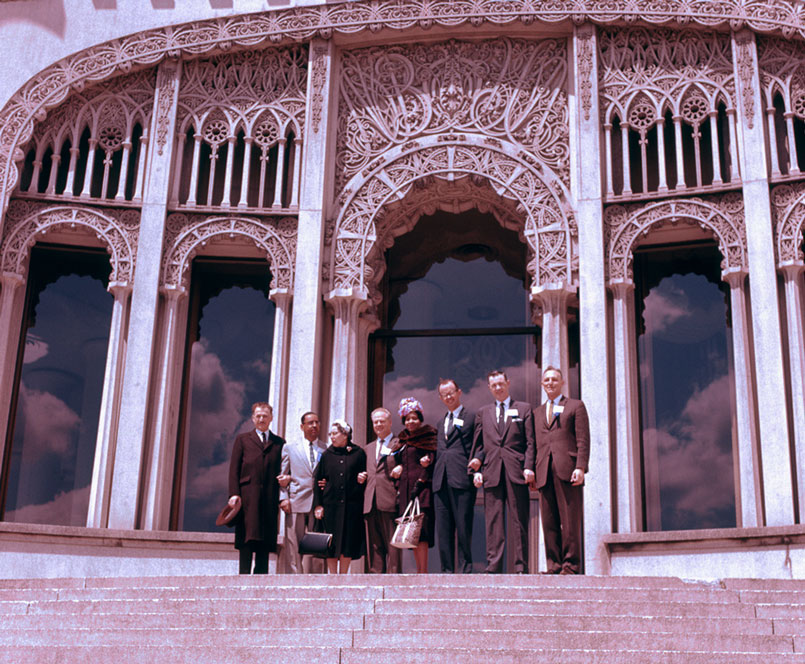
National Spiritual Assembly of the Bahá'ís of the United States 1961: Borrah Kavelin, Amos Gibson, Charlotte Linfoot, Charles Walcott, Sarah Pereira, Arthur Dahl, Hugh Chance, David Ruhe
(five would be elected to the first Universal House of Justice two years later)
An element of the Wilmette House of Worship was placed in the gardens of the Bahá'í World Centre in Haifa, Israel, near to the Shrine of the Bab.
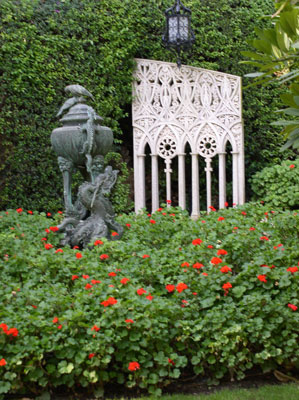
Element of the Wilmette Temple in the Bahá'í gardens in Haifa
This section is also available as a separate presentation in powerpoint and pdf formats.
Building a Bahá'í House of Worship for Africa was one of the goals of the Ten Year Crusade 1953-1963. It is located on a hill in Kampala, Uganda, and was dedicated on 14 January 1961, with over 900 Bahá'ís attending. It was opened to public worship on 15 January with many dignitaries in attendance.
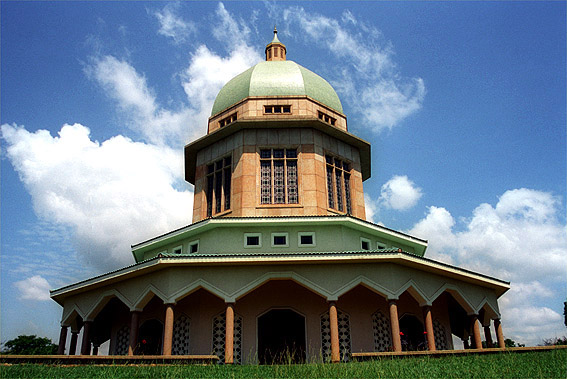 .
. 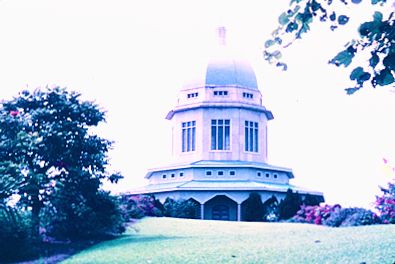
Bahá'í House of Worship in Kampala, Uganda
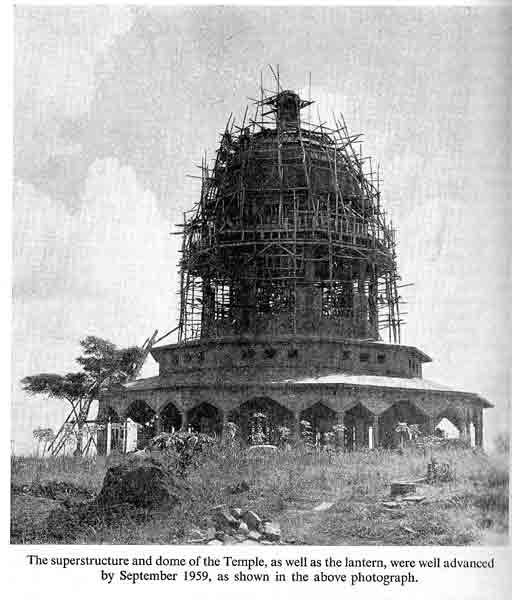
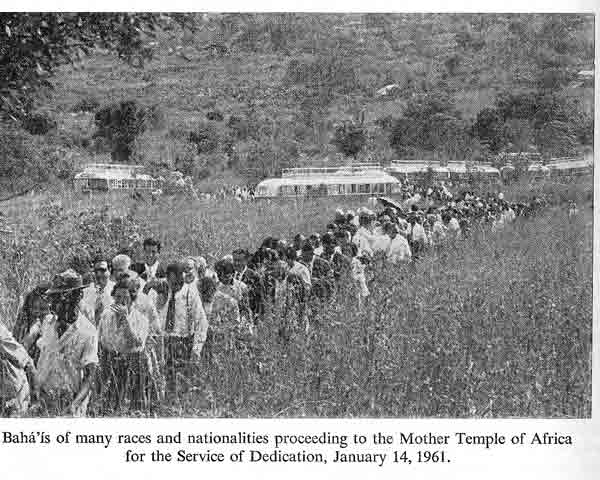
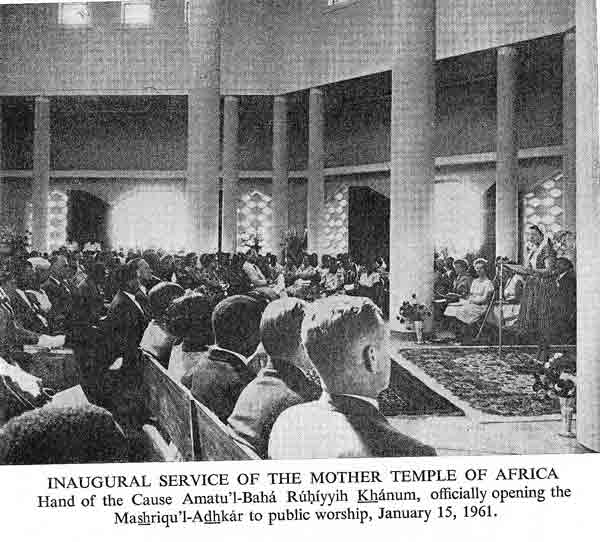
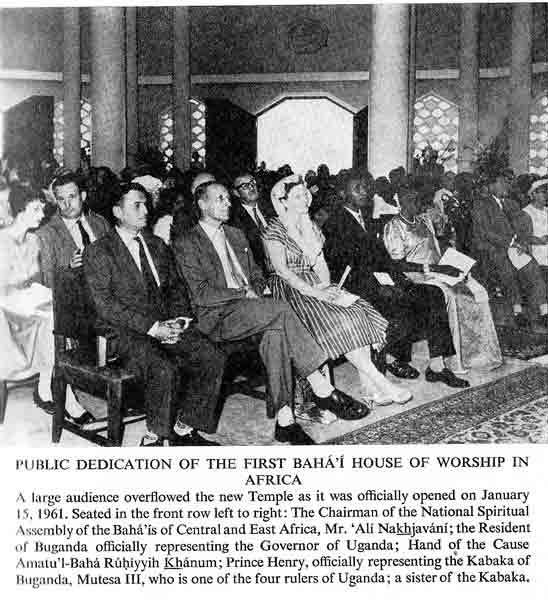
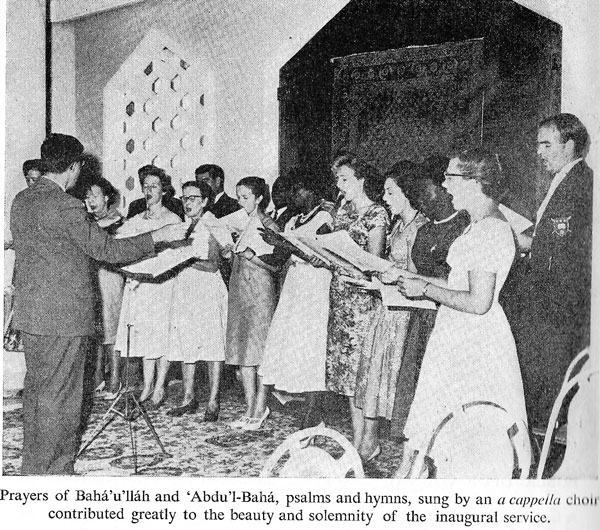
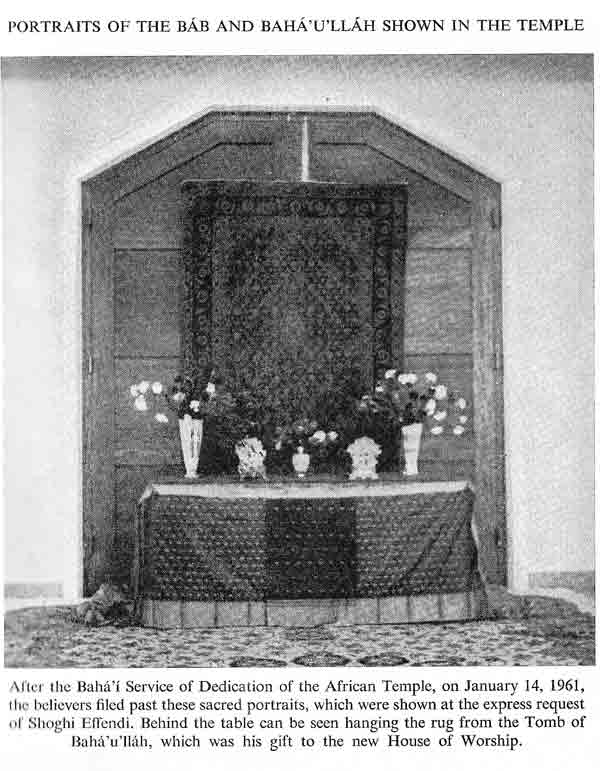
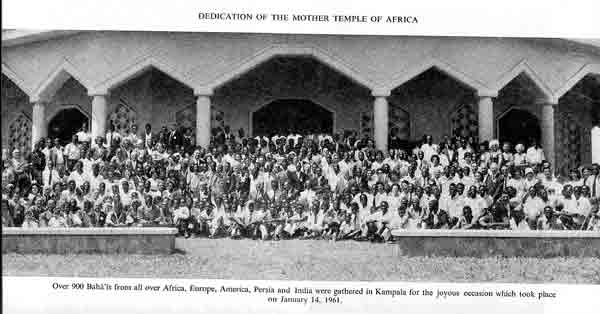
This section is also available as a separate presentation in powerpoint and pdf formats.
The Continental House of Worship for Australasia in Mona Vale, a suburb of Sydney, Australia, was another goal of the Ten Year Crusade and was dedicated on 16-17 September 1961.

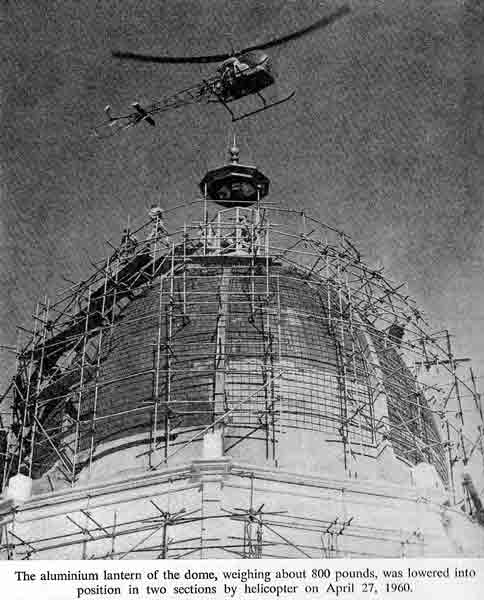 .
. 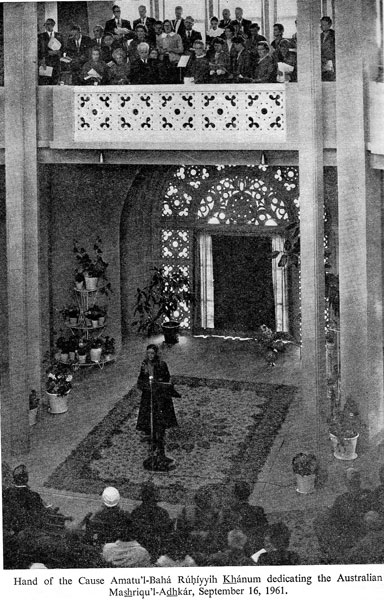
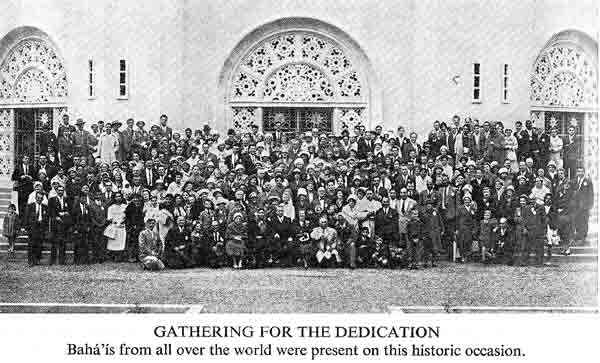
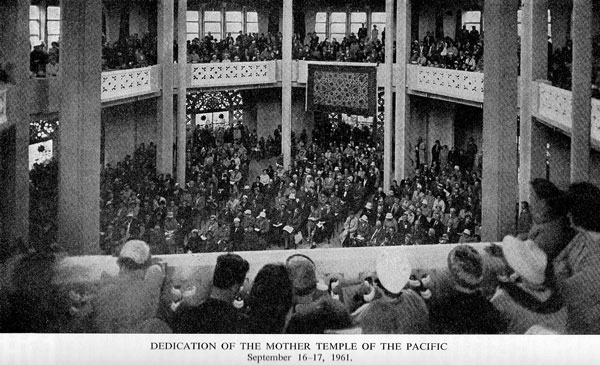
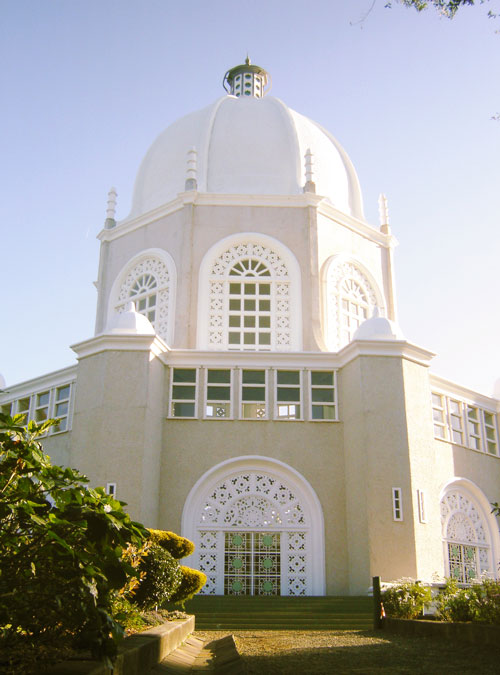 .
. 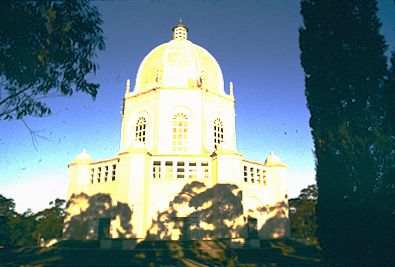
This section is also available as a separate presentation in powerpoint and pdf formats.
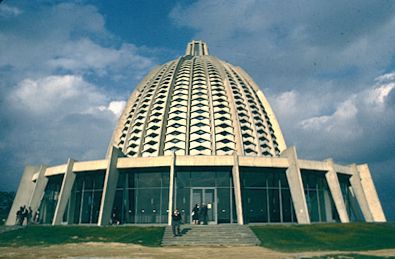 .
. 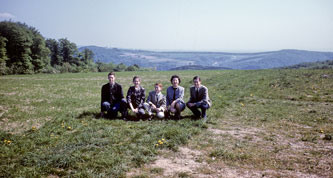
The House of Worship in 1966; me with my mother and brothers at the temple site in 1960
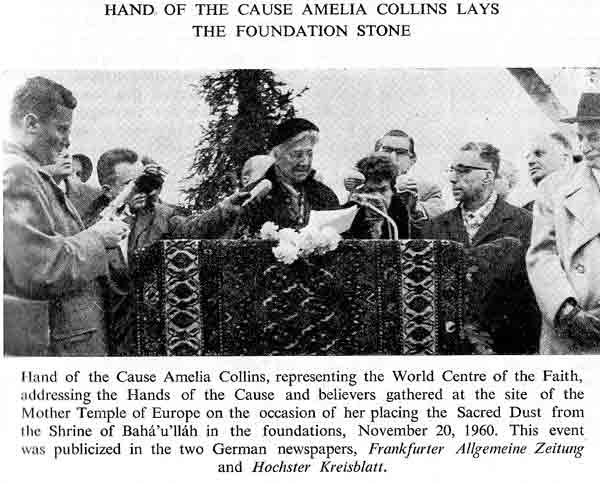
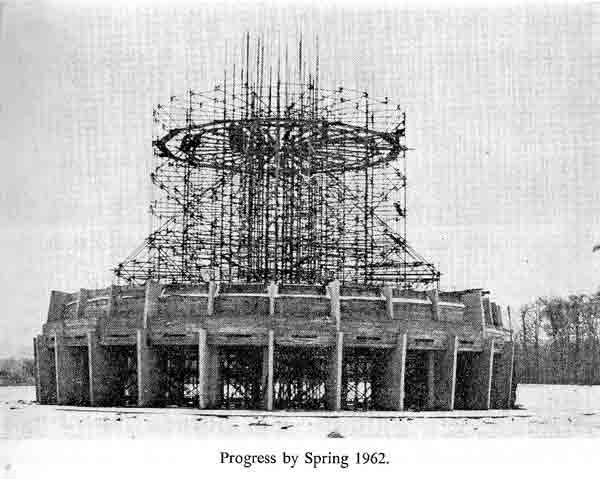
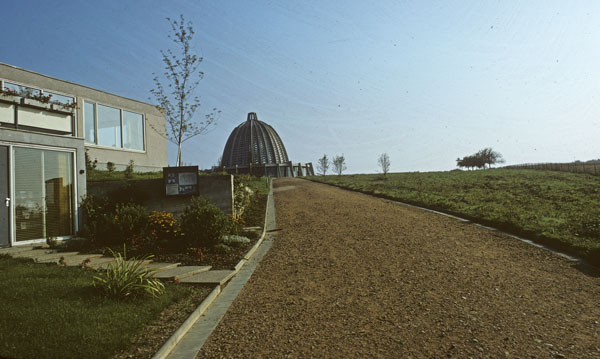
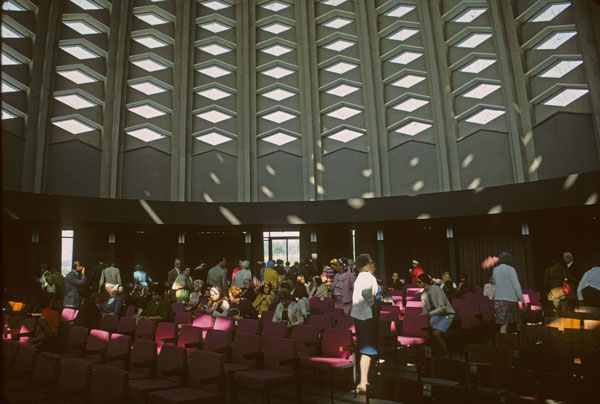
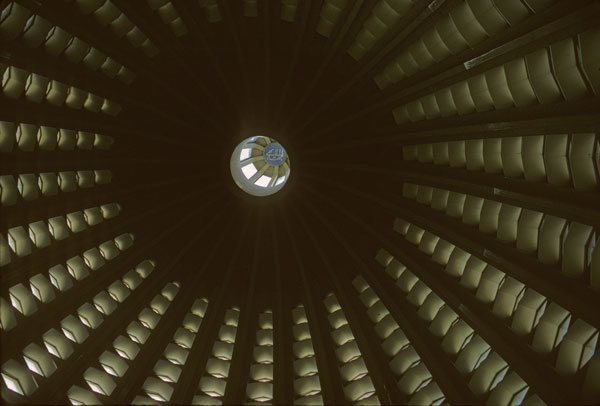
Inside the dome with the Greatest Name at the top
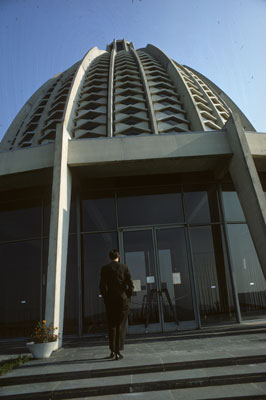 .
. 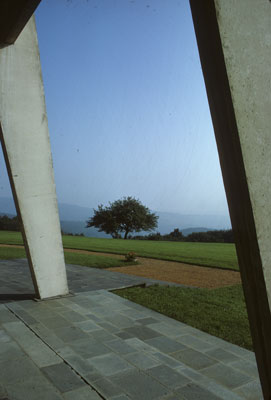 .
. 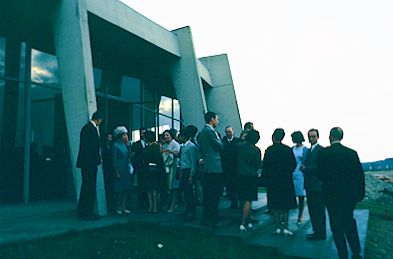
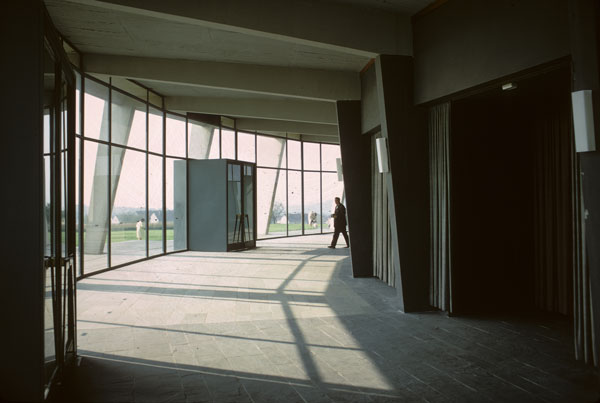 .
. 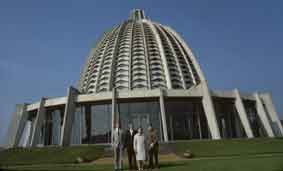
Inside the House of Worship; me with my Mother and two brothers at the Temple in 1968
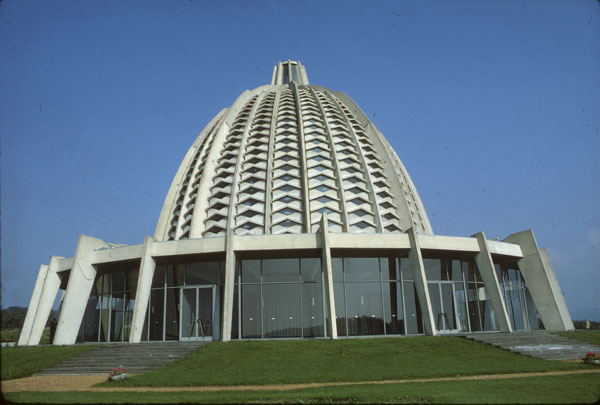
This section is also available as a separate presentation in powerpoint and pdf formats.
On the Cerro Sonsonate (singing hill) at an elevation of 225 meters north of Panama City alongside the Transisthmian Highway, the Continental Bahá'í House of Worship for Central America, under construction since 1967, was dedicated to public worship on 29-30 April 1972. Bahá'ís gathered from all over the Americas and around the world to celebrate the occasion, with an International Conference on 1-2 May 1972.
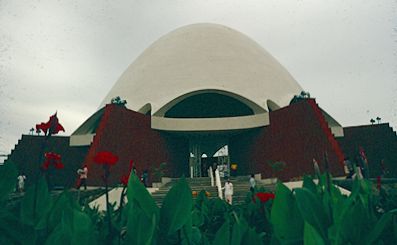 .
. 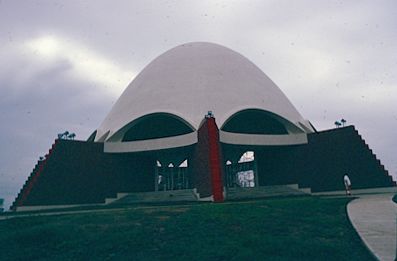
Continental House of Worship for Central America
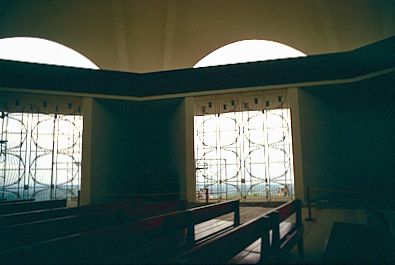 .
. 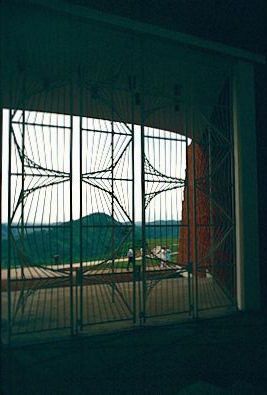 .
. 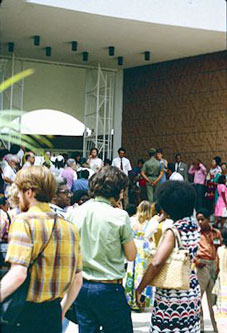
Interior; view through unique doors; crowd at the dedication
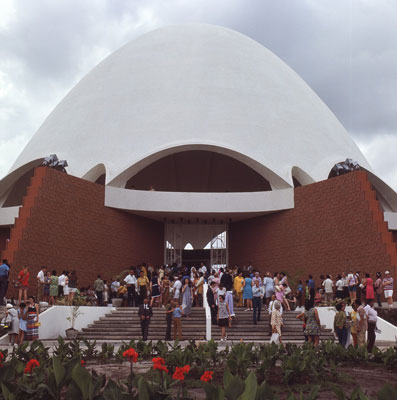 .
. 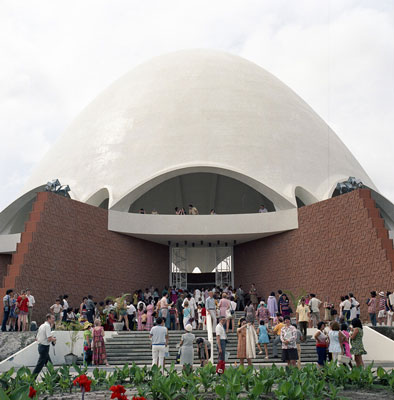
Crowd at the dedication
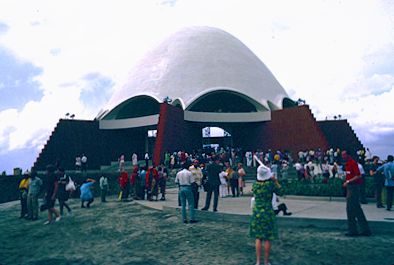 .
. 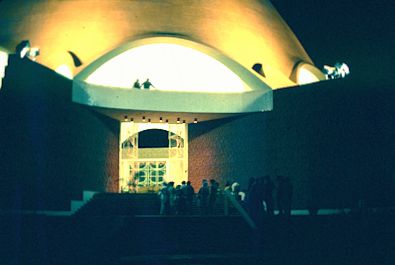
Temple with my Mother (green dress) and brother Keith (red shirt); temple at night
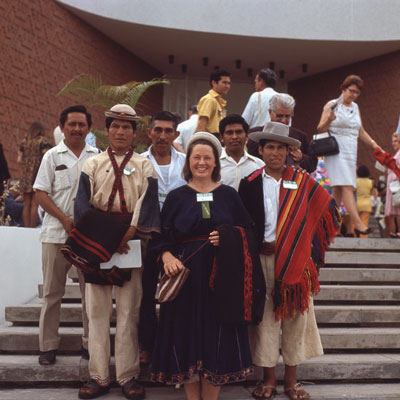 .
. 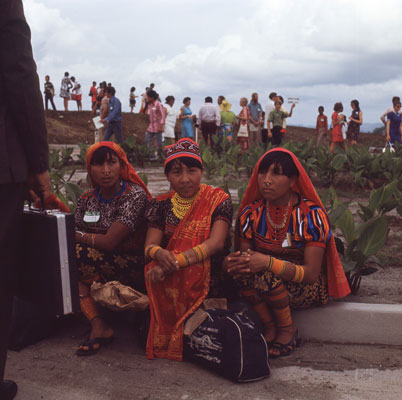
Many indigenous Baha'is including Cuna indians attended
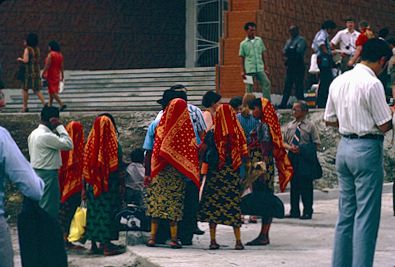 .
. 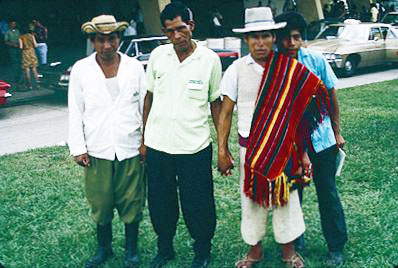
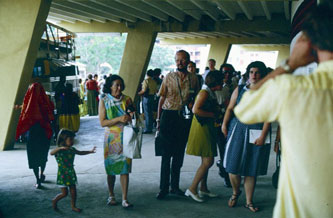 .
. 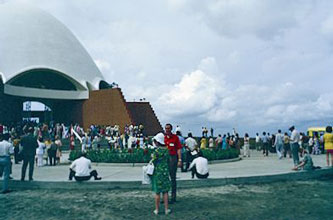 .
. 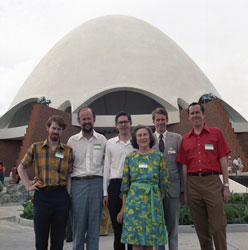
My Mother and Dad at the conference; Mother and Keith at the temple; my whole family
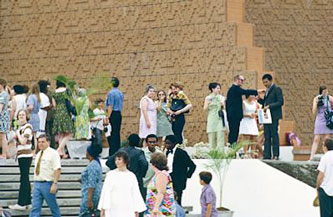 .
. 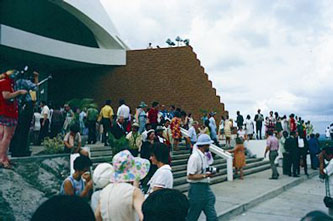 .
. 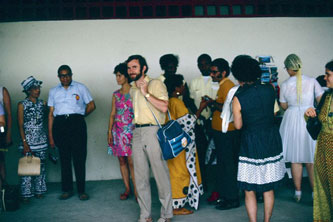
Brother Greg; Dad; John and Ruhi Huddleston from Virginia
Along with the dedication of the House of Worship, there was also an international conference on 1-2 May to bring together all the participants in the dedication and to encourage the teaching work, featuring prominent speakers including Hands of the Cause of God Ruhiyyih Khanum, Zikrullah Khadem and Ugo Giacheri.
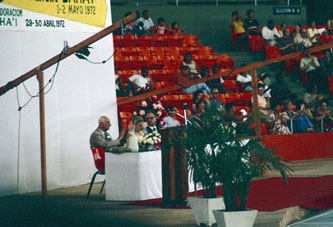 .
. 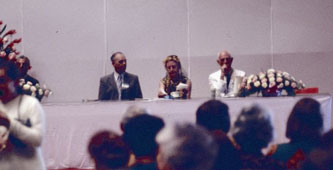 .
. 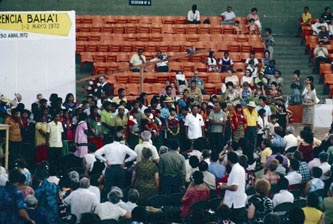
Hands of the Cause; Zikrullah Khadem, Ruhiyyih Khanum, Ugo Giacheri; choir
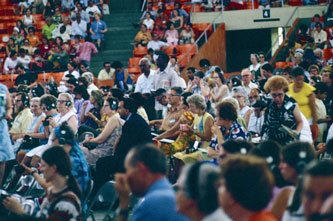 .
. 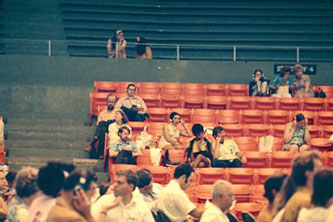 .
. 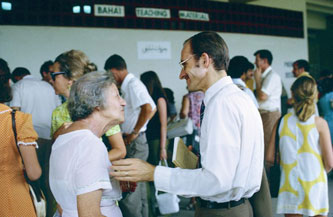
Audience with Peter Khan; brother Roger, Dad, Mother, Greg; Leonora Holsapple Armstrong, first Baha'i in Brazil (1921), and Hooper Dunbar
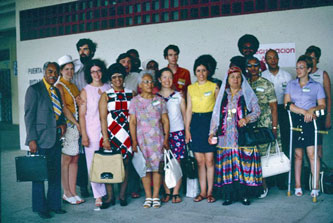 .
. 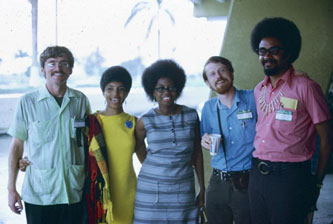 .
. 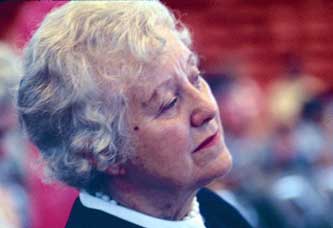
Baha'is from the Washington, DC area; brother Greg, Van Gilmer and friends; Sylvia Ioas (widow of Hand of the Cause Leroy Ioas)
For pictures of my family at the dedication, see separate page.
This section is also available as a separate presentation in powerpoint and pdf formats.
The Bahá'í House of Worship for the Pacific Islands sits on a mountainside behind Apia, Samoa. It was designed by the architect Hossein Amanat, who also designed buildings on the arc at the Bahá'í World Centre on Mount Carmel in Haifa, Israel.
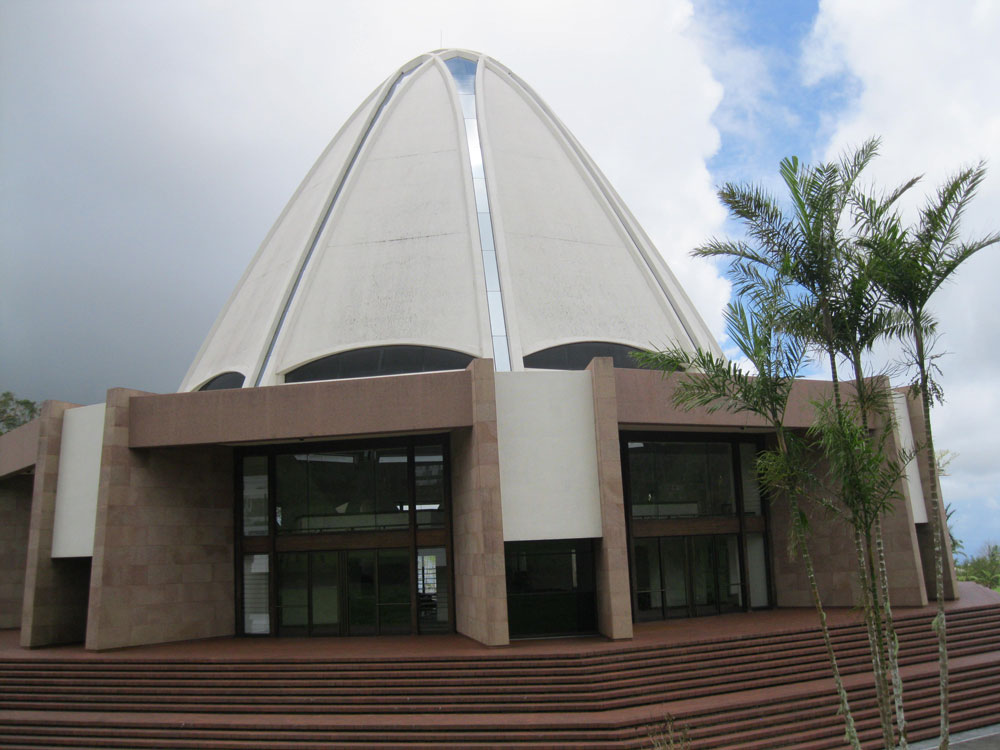
The Apia House of Worship
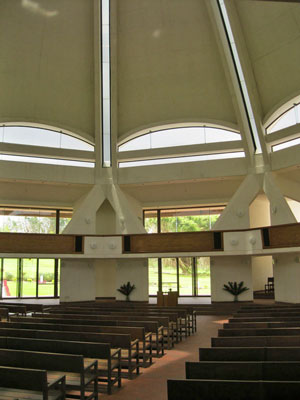 .
. 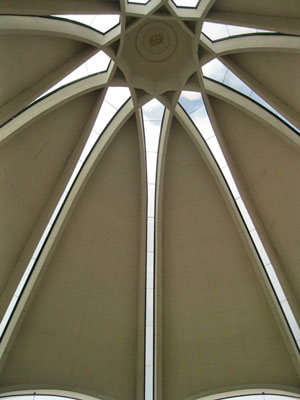
Interior views
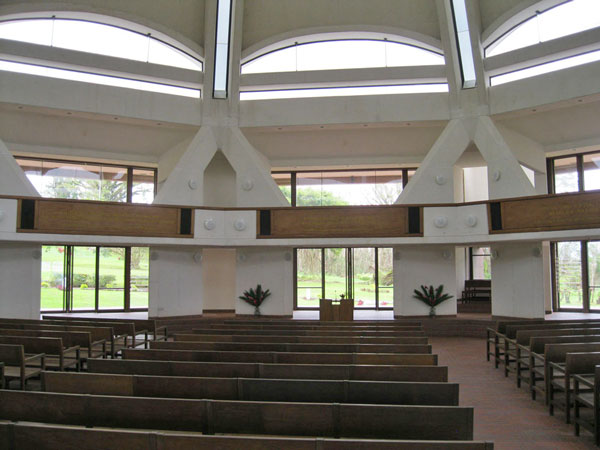
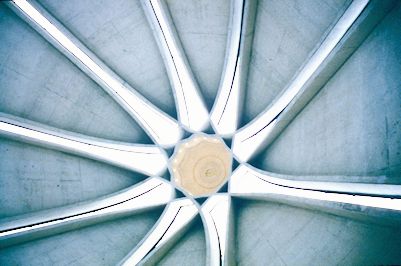 .
. 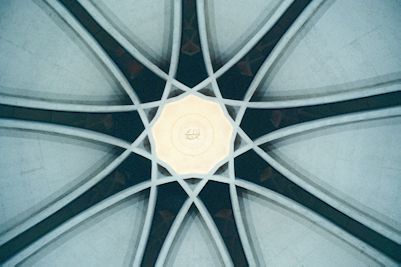
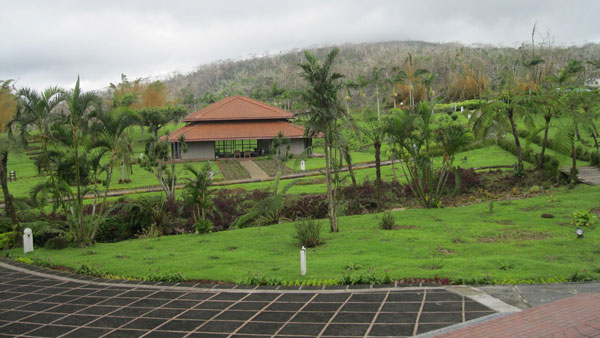
Extensive gardens surround the House of Worship, and nearby are the graves of Hand of the Cause Ugo Giacheri, who did much to teach the Baha'i Faith to the Head of State, and Counsellor Suhayl Ala'i, who lived many decades in Samoa.
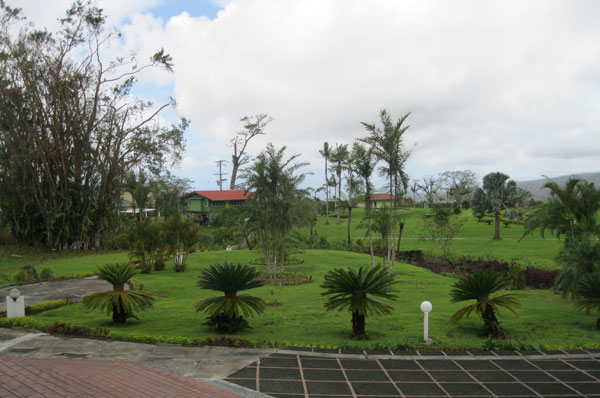
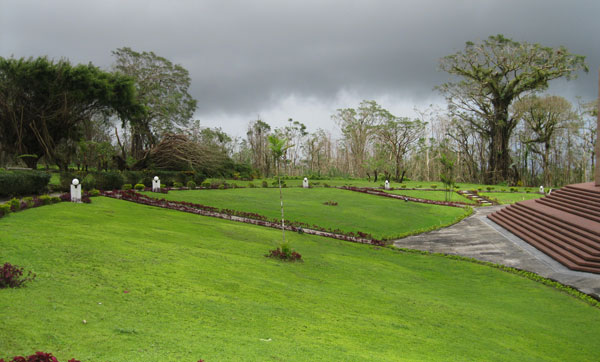
The House of Worship was dedicated on 30 August-2 September 1984 by Hand of the Cause Ruhiyyih Khanum in the presence of the Head of State, His Highness Susuga Malietoa Tanumafili II, the first ruling Head of State to become a Bahá'í. My wife Martine made the official film of the dedication, and my brother Keith, a long-time pioneer to Samoa, and I were official photographers. My mother and children also attended the dedication. I first visited Samoa in 1969 for a Baha'i youth conference, and have made many trips there since, spending more than a year there altogether, so I feel very close to the people of Samoa.
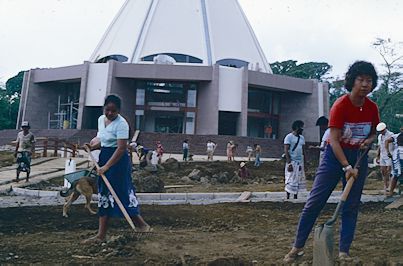 .
. 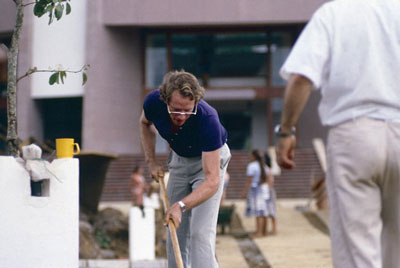
We all helped to prepare the gardens before the dedication; me working in the garden
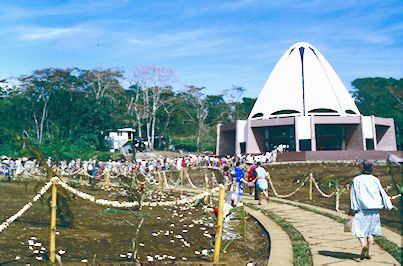 .
. 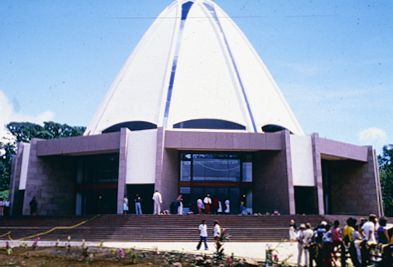
My mother (right) walking toward the temple; getting ready for the dedication
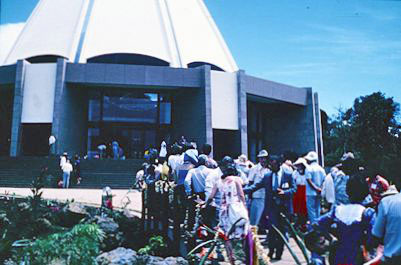 .
. 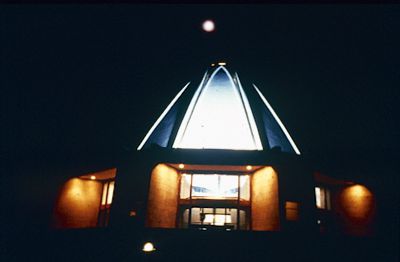
Arriving for the dedication; the temple at night
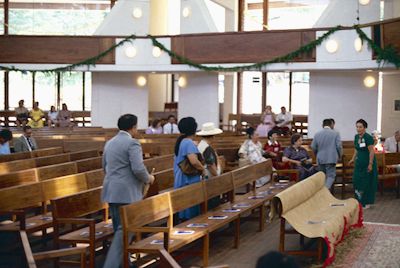 .
. 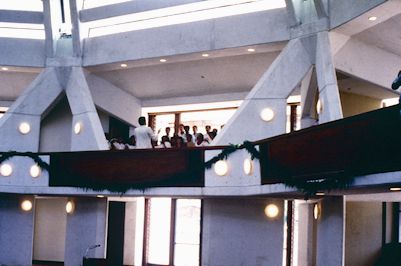
Lilian Ala'i, Knight of Bahá'u'lláh for Samoa as the first Bahá'í to go there in 1954 (green dress), showed guests to their seats; a choir provided music
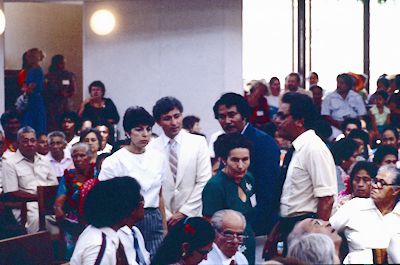 .
. 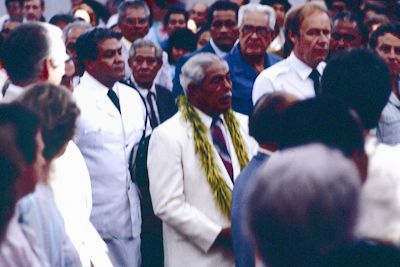
The architect of the House of Worship Hossein Amanat and his wife; arrival of the Head of State, Malietoa Tanumafili II
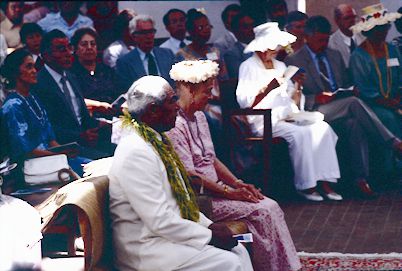 .
. 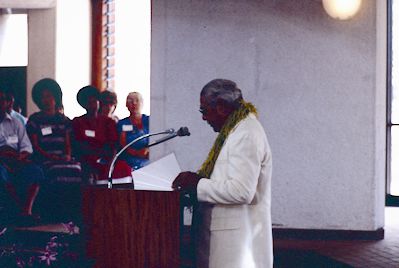
The Malietoa and Ruhiyyih Khanum; Malietoa speaking at the dedication
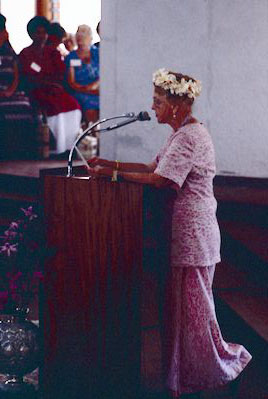 .
. 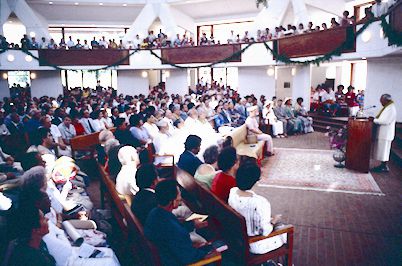
Ruhiyyih Khanum dedicating the House of Worship
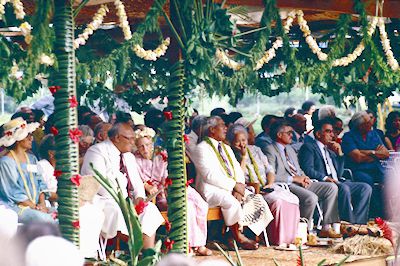 .
. 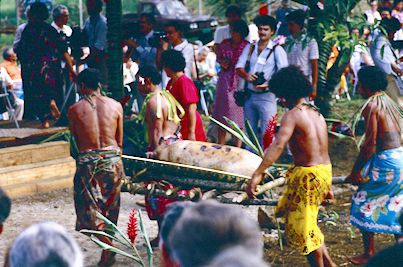
After the dedication ceremony, there was a traditional Samoan celebration with gifts for the honoured guests, including whole roast pigs
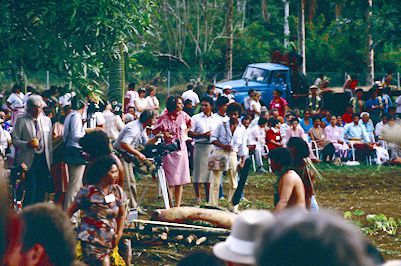 .
. 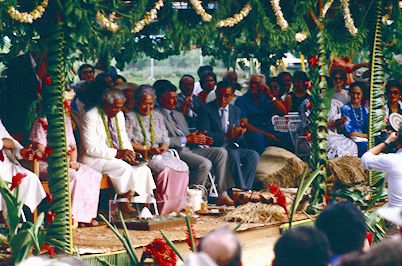
My wife Martine and her film crew; the Head of State was presented with a model of the House of Worship
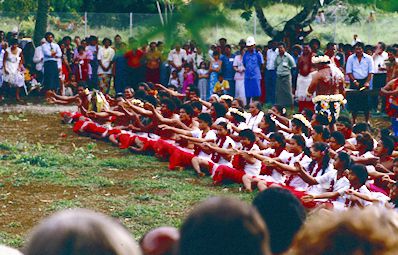 .
. 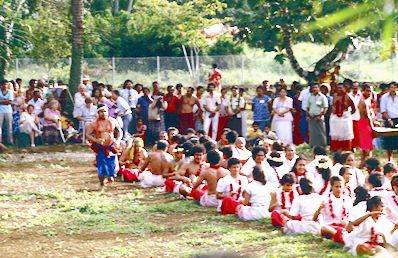
The youth performed traditional Samoan dances and songs
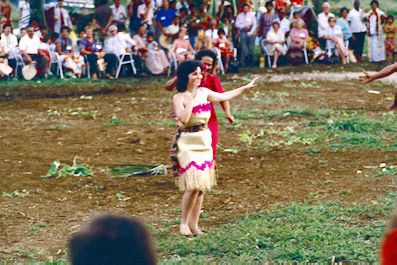 .
. 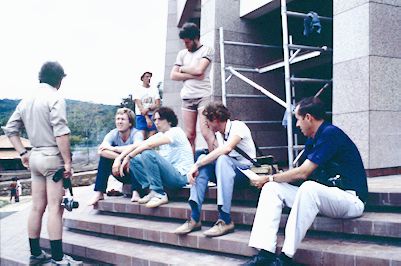
A beautiful young girl dances, in this case Sitarih Ala'i, the daughter of Suhayl and Lilian Ala'i; photographers, including my wife Martine, me and my brother Keith
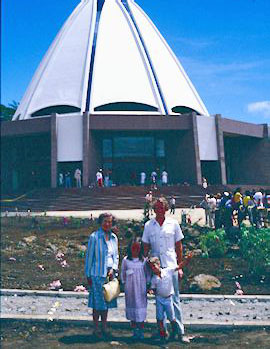 .
. 
Me with my mother, brother and children
For more pictures of the dedication, see the separate page
This section is also available as a separate presentation in powerpoint and pdf formats.
Dedication of the New Delhi House of Worship in December 1968, with Ruhiyyih Khanum (from International Audiovisual Centre slide programme). Often called the "Lotus Temple", it attracts more visitors than the Taj Mahal.
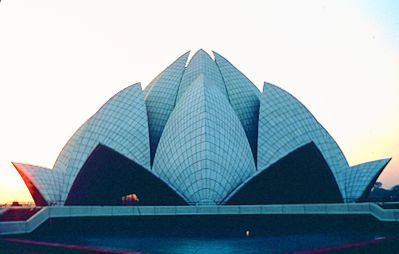 .
. 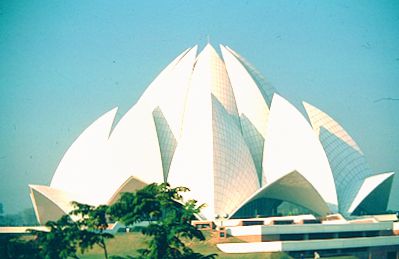
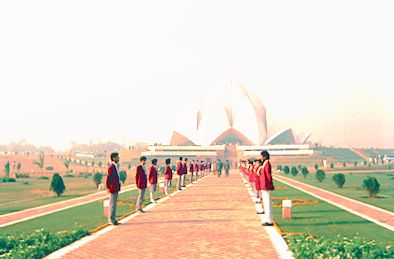 .
. 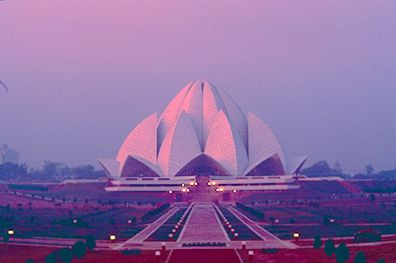
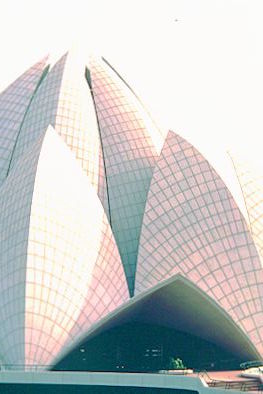 .
. 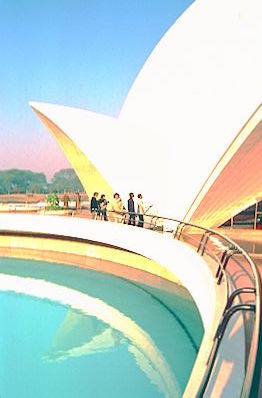 .
. 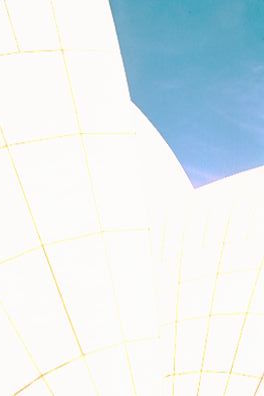
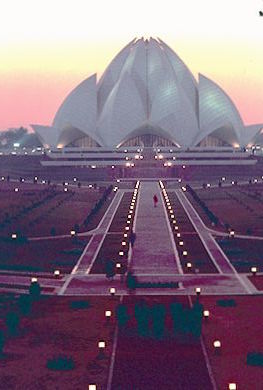 .
. 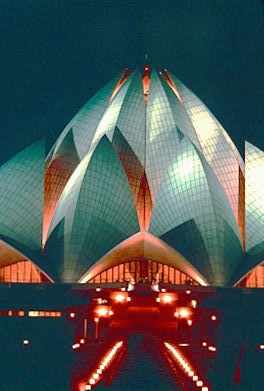 .
. 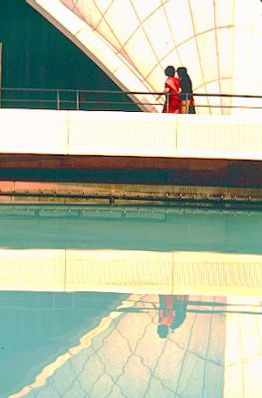
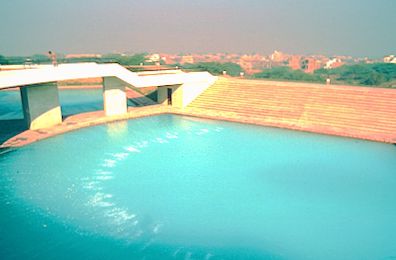 .
. 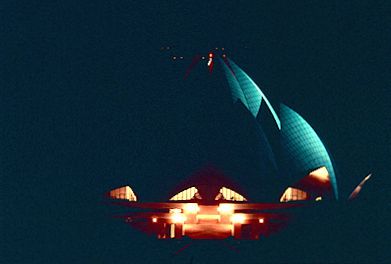
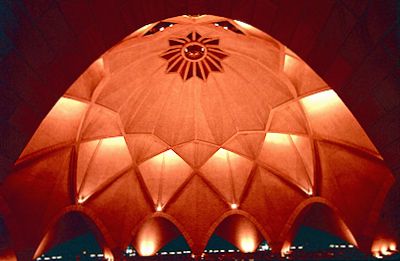 .
. 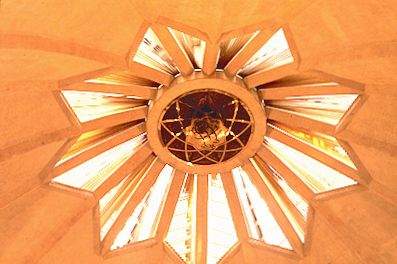
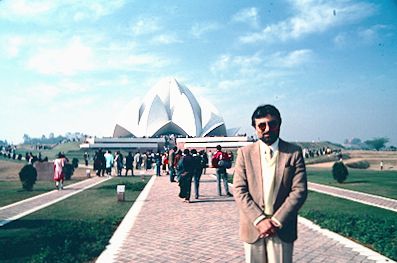 .
. 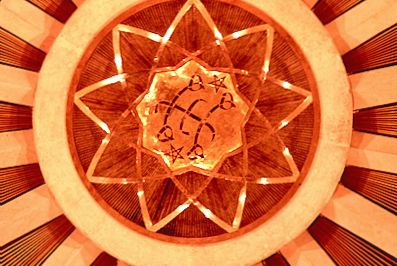
The architect of the House of Worship, Fariborz Sahba; the Greatest Name in the centre of the dome
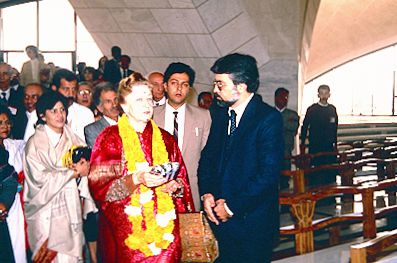 .
. 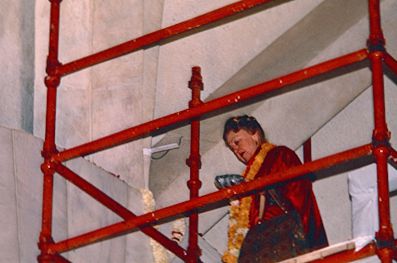
Ruhiyyih Khanum and Fariborz Sahba, the architect; placing a memento from the Baha'i Holy Places in the temple
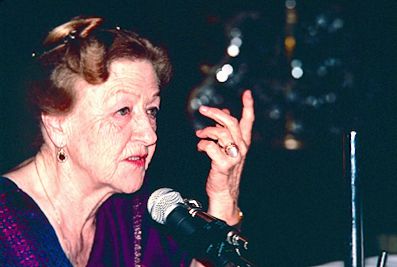 .
. 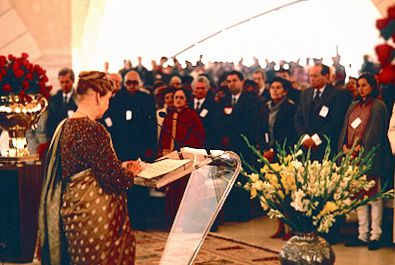
Ruhiyyih Khanum dedicating the House of Worship
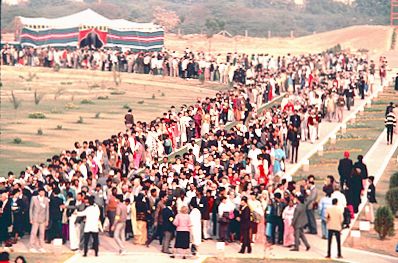 .
. 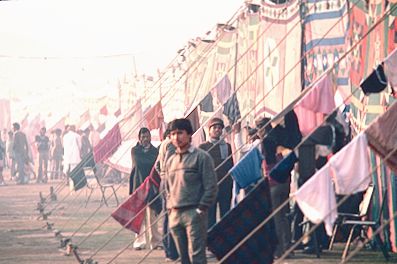
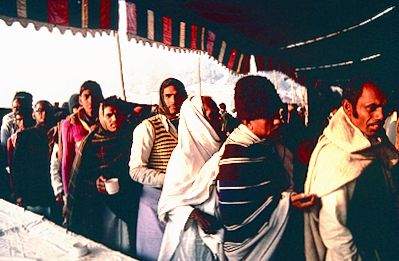 .
. 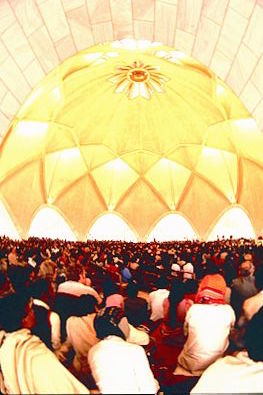
An International Teaching Conference was held after the dedication.
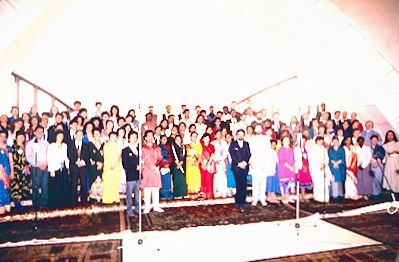 .
. 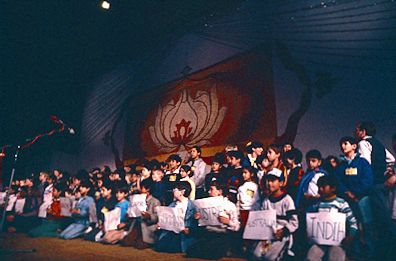
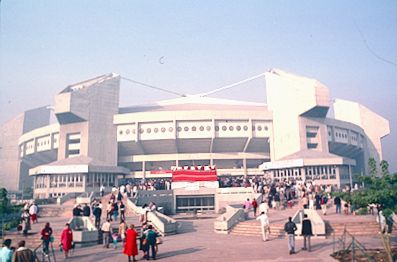 .
. 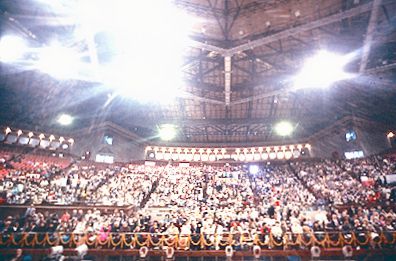
The international conference after the dedication
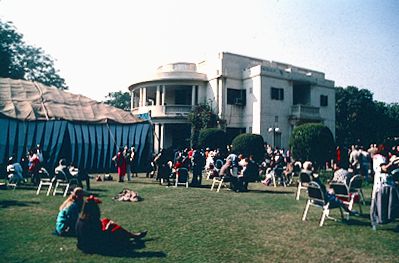
This section is also available as a separate presentation in powerpoint and pdf formats.
The last Continental House of Worship, for South America, is high on a hill overlooking Santiago, Chile, with the Andes behind. As with all Bahá’í Houses of Worship, the Santiago temple has a dome and nine entrances, but this one is composed of nine translucent “wings” spiralling to the centre, enclosing a volume about 30 metres in each dimension, making what is truly a “temple of light”. Glass, stone, bronze and wood are combined in exquisite beauty and attention to detail. The gardens and pools also spiral around the temple, recently planted with native shrubs that will take some years to reach maturity.
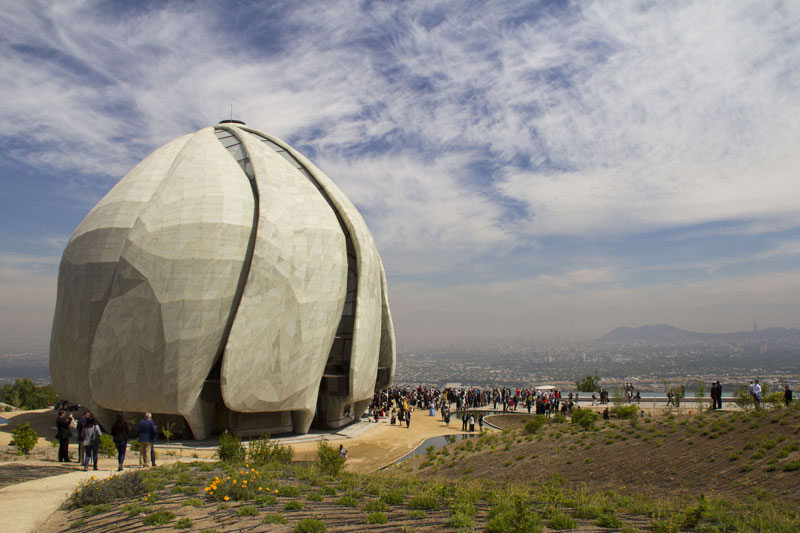
The House of Worship is a unique architectural gem. The nine wings have an internal metal structure covered on the outside with translucent panels of highly resistant glass recycled from the manufacture of laboratory apparatus, and on the inside with translucent white alabaster. Glass between the wings and below around the auditorium and balcony provides views of the gardens, the Andes and the city below. Light enters during the day, and radiates out at night. The temple can accommodate about 600. The doors and fittings are bronze and the balcony is covered in dark wood.
The House of Worship was dedicated on 13-16 October 2016 in a ceremony and associated conference of high spiritual significance and artistic beauty. Five thousand Baha’is, 3,000 from Latin America and 2,000 from the rest of the world, gathered for the occasion.
I was privileged to be one of those present. This was the fourth dedication that I have attended, after those of Wilmette (1953), Panama (1972) and Samoa (1984). The dedication ceremonies were at the Temple, a dramatic structure in Peñalolén, with the Andes rising behind on one side and the city of Santiago spread out below on the other. On Saturday afternoon and Sunday, groups of 500 went to the temple for a short ceremony with prayers, beautiful choir music, and a rare opportunity to view portraits of Bahá’u’lláh and the Báb, while the remainder followed artistic activities and videos from across South America and around the world at the conference.
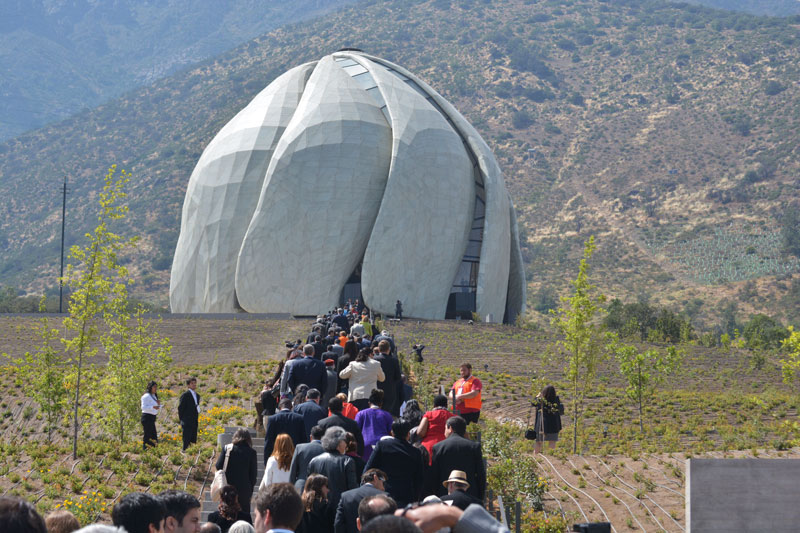
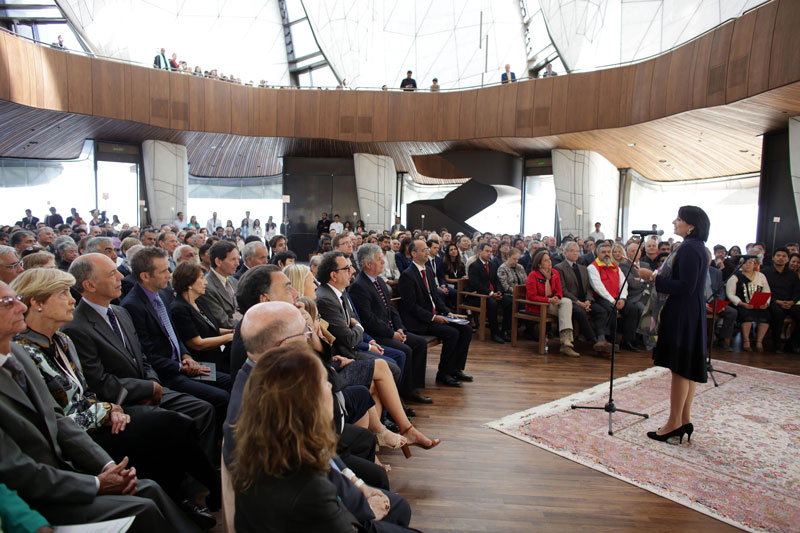
A dedication ceremony
When it was our turn to attend a dedication ceremony at the temple, we were 500 taken by bus to the temple site. We waited in a reception tent for our group to gather and for the previous group to leave the temple, admiring the site with its extensive view over Santiago below, and the green backdrop of the Andes behind. Then we climbed the stairs to the temple and entered quietly into such a beautiful building for the first time. We were welcomed briefly by the Representative of the Universal House of Justice. The choir on the balcony sang some quotations from the Baha’i writings, and other were read and chanted. Then we slowly filed out, passing and paying our respects to the portraits of Bahá’u’lláh and The Báb that had exceptionally been brought from the Bahá’í World Centre for this unique occasion.
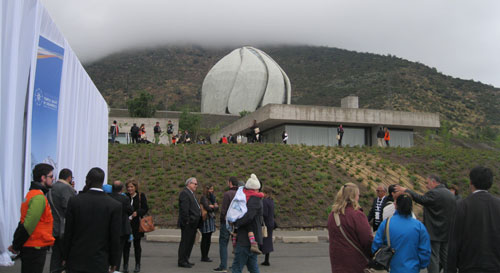 .
. 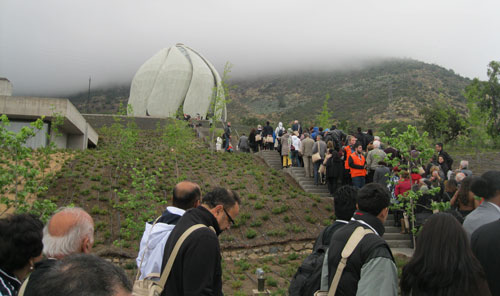
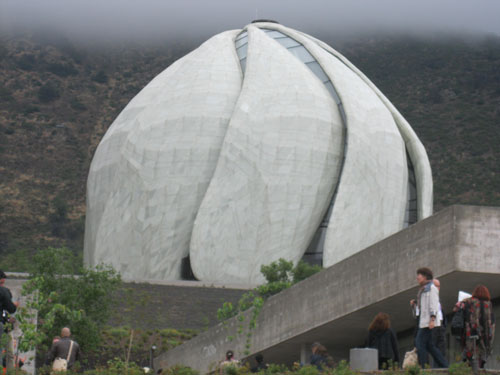 .
. 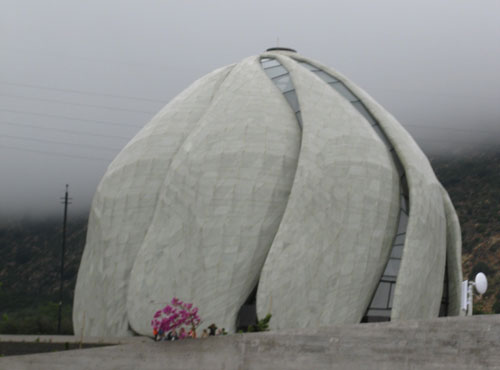
The conference was held in the Movistar Arena in downtown Santiago, while groups of 500 attended a dedication ceremony at the Temple. The first afternoon featured indigenous peoples, with a representative of the government appreciating the work of the Bahá’ís, quotations on the importance of the indigenous peoples, experiences of some of the indigenous believers, and music and dance, including a unity dance with many tribes together. There were musical presentations, videos of socio-economic development projects, messages from other Bahá’í communities around the world, and a true feeling of unity and celebration among all present. I represented Switzerland and made a short presentation.
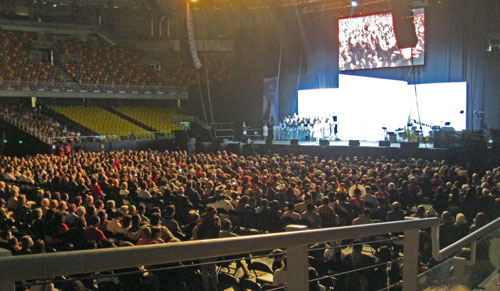 .
. 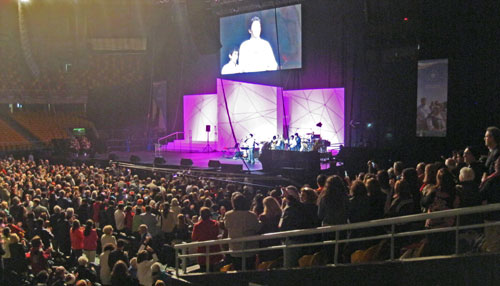
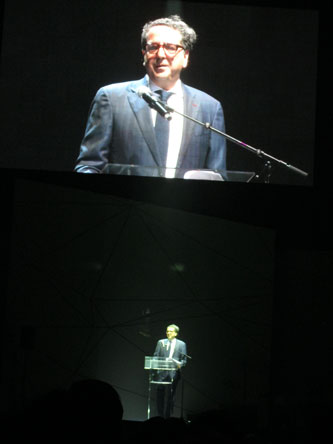 .
. 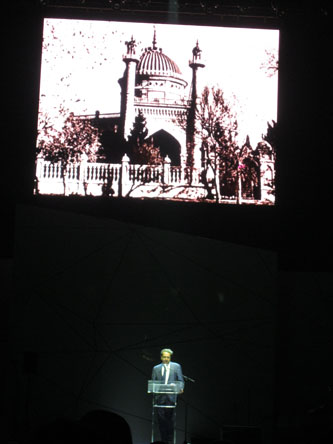 .
. 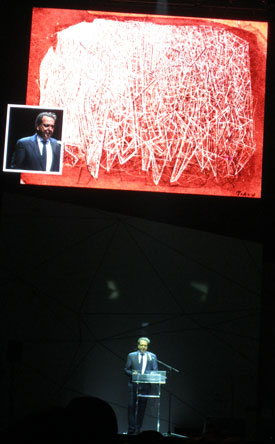
Siamak Hariri explaining his sources of inspiration for the Temple design, including a Mark Tobey painting "Lovers of Light"
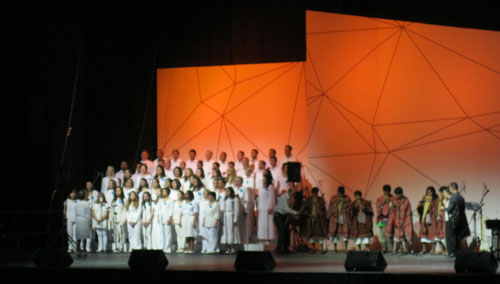 .
. 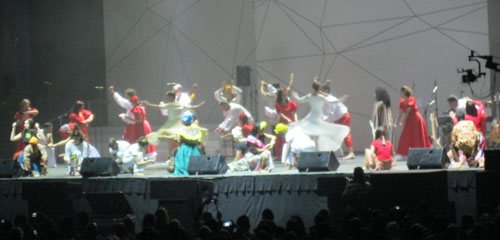
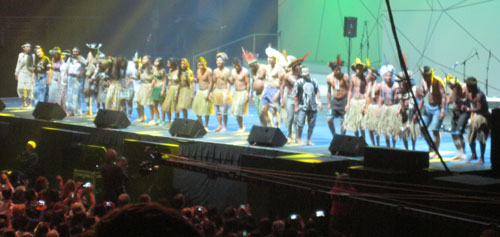 .
. 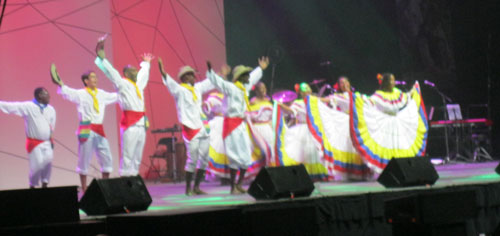
The closing plenary featured a talk by Dr. Farzam Arbab, who spent many years in South America starting in Colombia in 1969 before serving at the International Teaching Centre and for 20 years on the Universal House of Justice at the Bahá’í World Centre in Haifa, Israel. There were also Bahá’í songs by leading artists of South America that had everyone on their feet and some dancing in the aisles.
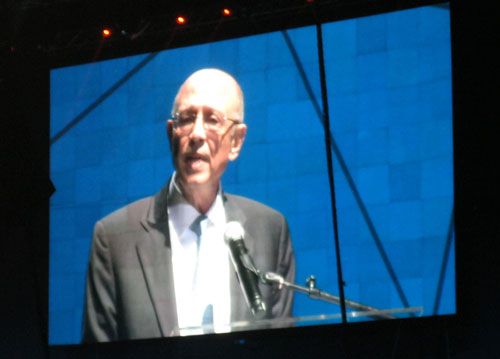 .
. 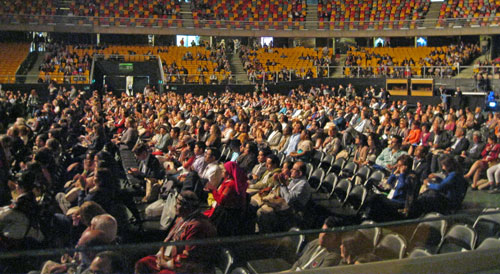
Dr. Farzam Arbab speaking
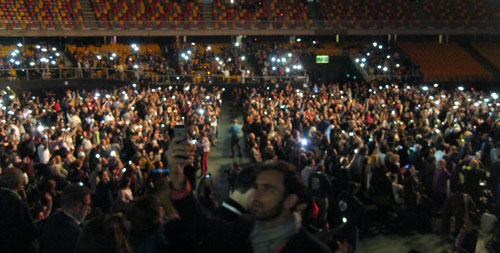 .
. 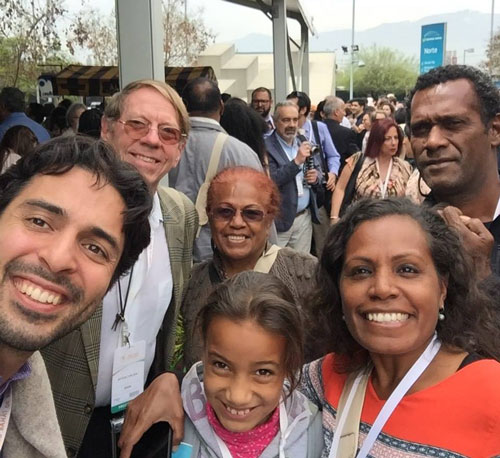
Waving lights at the closing of the conference; me with some old friends from New Caledonia
For more pictures on the dedication, see the separate page
This section is also available as a separate presentation in powerpoint and pdf formats.